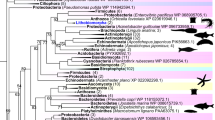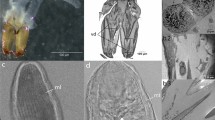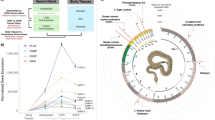Abstract
Venoms are biochemical arsenals that have emerged in numerous animal lineages, where they have co-evolved with morphological and behavioural traits for venom production and delivery. In centipedes, venom evolution is thought to be constrained by the morphological complexity of their venom glands due to physiological limitations on the number of toxins produced by their secretory cells. Here we show that the uneven toxin expression that results from these limitations have enabled Scolopendra morsitans to regulate the composition of their secreted venom despite the lack of gross morphologically complex venom glands. We show that this control is probably achieved by a combination of this heterogenous toxin distribution with a dual mechanism of venom secretion that involves neuromuscular innervation as well as stimulation via neurotransmitters. Our results suggest that behavioural control over venom composition may be an overlooked aspect of venom biology and provide an example of how exaptation can facilitate evolutionary innovation and novelty.
This is a preview of subscription content, access via your institution
Access options
Access Nature and 54 other Nature Portfolio journals
Get Nature+, our best-value online-access subscription
$32.99 / 30 days
cancel any time
Subscribe to this journal
Receive 12 digital issues and online access to articles
$119.00 per year
only $9.92 per issue
Buy this article
- Purchase on SpringerLink
- Instant access to full article PDF
Prices may be subject to local taxes which are calculated during checkout




Similar content being viewed by others
Data availability
Data are available from the corresponding author upon request. The mass spectrometry proteomics data have been deposited to the ProteomeXchange Consortium via the PRIDE49 partner repository with the dataset identifier PXD048264. Transcriptome data used can be found under NCBI BioProject accessions PRJNA200640 and PRJNA540703. MSI and VolumeScope data are available through UQ eSpace at https://doi.org/10.48610/0156525 (ref. 50).
References
Schendel, V., Rash, L. D., Jenner, R. A. & Undheim, E. A. B. The diversity of venom: the importance of behavior and venom system morphology in understanding its ecology and evolution. Toxins 11, 666 (2019).
Zancolli, G. & Casewell, N. R. Venom systems as models for studying the origin and regulation of evolutionary novelties. Mol. Biol. Evol. 37, 2777–2790 (2020).
Inceoglu, B. et al. One scorpion, two venoms: prevenom of Parabuthus transvaalicus acts as an alternative type of venom with distinct mechanism of action. Proc. Natl Acad. Sci. USA 100, 922–927 (2003).
Walker, A. A. et al. The assassin bug Pristhesancus plagipennis produces distinct venoms in separate gland lumens. Nat. Commun. 9, 755 (2018).
Dutertre, S. et al. Evolution of separate predation- and defence-evoked venoms in carnivorous cone snails. Nat. Commun. 5, 3521 (2014).
Hamilton, B. R. et al. Mapping enzyme activity on tissue by functional mass spectrometry imaging. Angew. Chem. 132, 3883–3886 (2020).
Rosenberg, J. & Hilken, G. Fine structural organization of the poison gland of Lithobius forficatus (Chilopoda, Lithobiomorpha). Nor. J. Entomol. 53, 119–127 (2006).
Dugon, M. M. & Arthur, W. Comparative studies on the structure and development of the venom-delivery system of centipedes and a hypothesis on the origin of this evolutionary novelty. Evol. Dev. 14, 128–137 (2012).
Undheim, E. A. B. et al. Production and packaging of a biological arsenal: evolution of centipede venoms under morphological constraint. Proc. Natl Acad. Sci. USA 112, 4026–4031 (2015).
Jami, S., Erickson, A., Brierley, S. M. & Vetter, I. Pain-causing venom peptides: insights into sensory neuron pharmacology. Toxins 10, 15 (2018).
Yin, K., Baillie, G. J. & Vetter, I. Neuronal cell lines as model dorsal root ganglion neurons: a transcriptomic comparison. Mol. Pain 12, 1744806916646111 (2016).
Undheim, E. A. B. & King, G. F. On the venom system of centipedes (Chilopoda), a neglected group of venomous animals. Toxicon 57, 512–524 (2011).
Hanselmann, M. et al. Concise representation of mass spectrometry images by probabilistic latent semantic analysis. Anal. Chem. 80, 9649–9658 (2008).
Müller, C. H. G., Rosenberg, J. & Hilken, G. Ultrastructure, functional morphology and evolution of recto-canal epidermal glands in Myriapoda. Arthropod Struct. Dev. 43, 43–61 (2014).
Baumann, O., Kühnel, D., Dames, P. & Walz, B. Dopaminergic and serotonergic innervation of cockroach salivary glands: distribution and morphology of synapses and release sites. J. Exp. Biol. 207, 2565–2575 (2004).
Ali, D. W. The aminergic and peptidergic innervation of insect salivary glands. J. Exp. Biol. 200, 1941–1949 (1997).
Duboscq, O. in Archives De Zoologie Expérimentale Et Générale Vol. 3 (ed. de Lacaze-Duthiers, H.) 481–655 (Centra National de la Recherche Scientifique, 1898).
Rilling, G. Lithobius forficatus (Gustav Fischer Verlag, 1968).
Proctor, G. B. & Carpenter, G. H. Salivary secretion: mechanism and neural regulation. Monogr. Oral Sci. 24, 14–29 (2014).
Hu, Y., Converse, C., Lyons, M. C. & Hsu, W. H. Neural control of sweat secretion: a review. Br. J. Dermatol. 178, 1246–1256 (2018).
Brown, J. W. & McKnight, C. J. Molecular model of the microvillar cytoskeleton and organization of the brush border. PLoS ONE 5, e9406 (2010).
Mooseker, M. S. Brush border motility: microvillar contraction in Triton-treated brush borders isolated from intestinal epithelium. J. Cell Biol. 71, 417–433 (1976).
Turcato, A. & Minelli, A. Fine structure of the ventral glands of Pleurogeophilus mediterraneus (Meinert) (Chilopoda, Geophilomorpha). In Proc. 7th International Congress of Myriapodology (ed. Minelli, A.) 165–173 (E. J. Brill, 1990).
Dass, C. M. S. & Jangi, B. S. Ultrastructural organization of the poison gland of the centipede Scolopendra morsitans Linn. Indian J. Exp. Biol. 16, 748–757 (1978).
Antoniazzi, M. M. et al. Comparative morphological study of the venom glands of the centipede Cryptops iheringi, Otostigmus pradoi and Scolopendra viridicornis. Toxicon 53, 367–374 (2009).
Just, F. & Walz, B. The effects of serotonin and dopamine on salivary secretion by isolated cockroach salivary glands. J. Exp. Biol. 199, 407–413 (1996).
Hilken, G. & Rosenberg, J. Ultrastructural investigation of a salivary gland in a centipede: structure and origin of the maxilla I-gland of Scutigera coleoptrata (Chilopoda, Notostigmophora). J. Morphol. 267, 375–381 (2006).
Kazandjian, T. D. et al. Physiological constraints dictate toxin spatial heterogeneity in snake venom glands. BMC Biol. 20, 148 (2022).
Safavi-Hemami, H. et al. Combined proteomic and transcriptomic interrogation of the venom gland of Conus geographus uncovers novel components and functional compartmentalization. Mol. Cell Proteom. 13, 938–953 (2014).
Marshall, J. et al. Anatomical correlates of venom production in Conus californicus. Biol. Bull. 203, 27–41 (2002).
Basak, O. et al. Induced quiescence of Lgr5+ stem cells in intestinal organoids enables differentiation of hormone-producing enteroendocrine cells. Cell Stem Cell 20, 177–190 (2017).
R Core Team. R: A Language and Environment for Statistical Computing (R Foundation for Statistical Computing, 2023).
Tang, Y., Horikoshi, M. & Li, W. ggfortify: unified interface to visualize statistical results of popular R packages. R J. 8, 478–489 (2016).
Candiano, G. et al. Blue silver: a very sensitive colloidal Coomassie G-250 staining for proteome analysis. Electrophoresis 25, 1327–1333 (2004).
Hale, J. E., Butler, J. P., Gelfanova, V., You, J. S. & Knierman, M. D. A simplified procedure for the reduction and alkylation of cysteine residues in proteins prior to proteolytic digestion and mass spectral analysis. Anal. Biochem. 333, 174–181 (2004).
Undheim, E. A. B. et al. Clawing through evolution: toxin diversification and convergence in the ancient lineage Chilopoda (centipedes). Mol. Biol. Evol. 31, 2124–2148 (2014).
Jenner, R. A., von Reumont, B. M., Campbell, L. I. & Undheim, E. A. B. Parallel evolution of complex centipede venoms revealed by comparative proteotranscriptomic analyses. Mol. Biol. Evol. 36, 2748–2763 (2019).
Silva, J. C., Gorenstein, M. V., Li, G. Z., Vissers, J. P. C. & Geromanos, S. J. Absolute quantification of proteins by LCMSE: a virtue of parallel MS acquisition. Mol. Cell Proteom. 5, 144–156 (2006).
Vetter, I. & Lewis, R. J. Characterization of endogenous calcium responses in neuronal cell lines. Biochem. Pharmacol. 79, 908–920 (2010).
Undheim, E. A. B. et al. Multifunctional warheads: diversification of the toxin arsenal of centipedes via novel multidomain transcripts. J. Proteom. 102, 1–10 (2014).
Katoh, K. & Standley, D. M. MAFFT multiple sequence alignment software version 7: improvements in performance and usability. Mol. Biol. Evol. 30, 772–780 (2013).
Kalyaanamoorthy, S., Minh, B. Q., Wong, T. K. F., Von Haeseler, A. & Jermiin, L. S. ModelFinder: fast model selection for accurate phylogenetic estimates. Nat. Methods 14, 587–589 (2017).
Nguyen, L.-T., Schmidt, H. A., von Haeseler, A. & Minh, B. Q. IQ-TREE: a fast and effective stochastic algorithm for estimating maximum-likelihood phylogenies. Mol. Biol. Evol. 32, 268–274 (2015).
Minh, B. Q., Nguyen, M. A. T. & Von Haeseler, A. Ultrafast approximation for phylogenetic bootstrap. Mol. Biol. Evol. 30, 1188–1195 (2013).
Han, M. V. & Zmasek, C. M. phyloXML: XML for evolutionary biology and comparative genomics. BMC Bioinf. 10, 356 (2009).
Schindelin, J. et al. Fiji: an open-source platform for biological-image analysis. Nat. Methods 9, 676–682 (2012).
Cardona, A. et al. TrakEM2 software for neural circuit reconstruction. PLoS ONE 7, e38011 (2012).
Saalfeld, S., Cardona, A., Hartenstein, V. & Tomančák, P. CATMAID: collaborative annotation toolkit for massive amounts of image data. Bioinformatics 25, 1984 (2009).
Perez-Riverol, Y. et al. The PRIDE database resources in 2022: a hub for mass spectrometry-based proteomics evidences. Nucleic Acids Res. 50, D543–D552 (2022).
Schendel, V. Dataset—Exaptation of an evolutionary constraint enables behavioural control over the composition of secreted venom in a giant centipede. UQ eSpace https://doi.org/10.48610/0156525 (2024).
Acknowledgements
This work was supported by the Australian Research Council (DECRA Fellowship DE160101142 and Discovery Grant DP160104025 to E.A.B.U.), the Norwegian Research Council (FRIPRO-YRT Fellowship no. 287462 to E.A.B.U.), the European Research Council (ERC Starting Grant 101039862 to E.A.B.U.) and the University of Queensland (International UQ Research Training PhD Scholarship to V.S.). We acknowledge the facilities and the scientific and technical assistance of the Australian Microscopy & Microanalysis Research Facility at the Centre for Microscopy and Microanalysis, The University of Queensland. We thank R. Sullivan (Queensland Brain Institute, The University of Queensland) for paraffin embedding samples for MSI. Computations were in part performed on resources provided by Sigma2—the National Infrastructure for High Performance Computing and Data Storage in Norway.
Author information
Authors and Affiliations
Contributions
E.A.B.U. conceived the study. E.A.B.U. and V.S. designed the study. V.S., B.R.H., S.D.R., K.G., M.E.S., D.B., J.L.S., J.P.O., K.L.V., S.S.M., I.V., L.D.R. and E.A.B.U. contributed to the acquisition and analysis of data. V.S. authored the main draft. All authors contributed to writing the manuscript and approve its final form.
Corresponding author
Ethics declarations
Competing interests
The authors declare no competing interests.
Peer review
Peer review information
Nature Ecology & Evolution thanks the anonymous reviewers for their contribution to the peer review of this work.
Additional information
Publisher’s note Springer Nature remains neutral with regard to jurisdictional claims in published maps and institutional affiliations.
Supplementary information
Supplementary Information
Supplementary Figs. 1–10, Tables 1 and 2, legends for Data 1–3 and Video 1.
Supplementary Data 1
Summaries of MALDI peak intensities from EV and DV, as well as proteomic protein abundance estimates for venom components identified in EV, DV and venom gland depletion experiments. (A) Compositional comparison of all EV and all DV, as shown in Fig. 1a. (B) Means of three most abundant (area) peptides for each protein. Areas are shown as parts per million of each respective sample’s summed areas of all high-confidence peptides assigned non-contaminant and non-decoy proteins in the peptide summary. Values were summarized from trimmed ProteinPilot peptide summaries provided in PRIDE under the accession PXD048264 using Supplementary Data 3. This table was used to generate Venn diagrams in Fig. 1a and PCA shown in Fig. 1b. (C) The log2-transformed values from (B), used to label phylogenetic trees in Fig. 1f and Supplementary Figs. 3–5. (D) Peak intensities from aligned MALDI MS spectra, used for PCA in Fig. 1c. (E) Areas of each of the three most abundant peptides selected for each protein in the depletion experiment, as selected using Supplementary Data 2, which have been normalized as parts per million of the total area of each sample in (F). The mean normalized parts per million is shown in (G), which was the table used for PCA shown in Fig. 2, Supplementary Fig. 6 and Supplementary Tables 1 and 2.
Supplementary Data 2
Findtop3.txt. Perl script used to extract top three unique peptides from ProteinPilot peptide summary.
Supplementary Data 3
Summarise_peptides.sh. Shell script used to summarize ProteinPilot peptide summaries from shotgun proteomic analyses of EV and DV.
Supplementary Video 1
The 3D reconstruction of S. morsitans venom gland imaged by MSI. Video of a ‘full’ venom gland. The distributions of four different venom gland components: m/z 6,005, 3,337, 3,640 and 5,815 are visualized as heatmaps: minimum (blue)–maximum (red).
Rights and permissions
Springer Nature or its licensor (e.g. a society or other partner) holds exclusive rights to this article under a publishing agreement with the author(s) or other rightsholder(s); author self-archiving of the accepted manuscript version of this article is solely governed by the terms of such publishing agreement and applicable law.
About this article
Cite this article
Schendel, V., Hamilton, B.R., Robinson, S.D. et al. Exaptation of an evolutionary constraint enables behavioural control over the composition of secreted venom in a giant centipede. Nat Ecol Evol 9, 73–86 (2025). https://doi.org/10.1038/s41559-024-02556-9
Received:
Accepted:
Published:
Issue date:
DOI: https://doi.org/10.1038/s41559-024-02556-9



